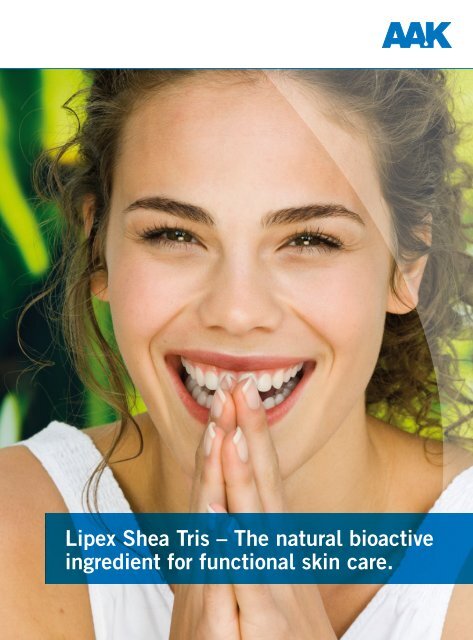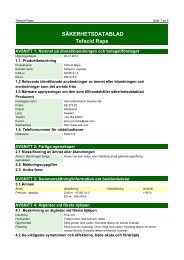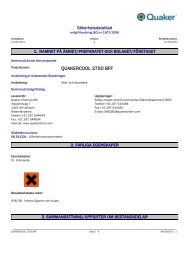Lipex Shea Tris – The natural bioactive ingredient for functional skin ...
Lipex Shea Tris – The natural bioactive ingredient for functional skin ...
Lipex Shea Tris – The natural bioactive ingredient for functional skin ...
You also want an ePaper? Increase the reach of your titles
YUMPU automatically turns print PDFs into web optimized ePapers that Google loves.
<strong>Lipex</strong> <strong>Shea</strong> <strong>Tris</strong> <strong>–</strong> <strong>The</strong> <strong>natural</strong> <strong>bioactive</strong><br />
<strong>ingredient</strong> <strong>for</strong> <strong>functional</strong> <strong>skin</strong> care.
<strong>Lipex</strong> ® <strong>–</strong> Per<strong>for</strong>mance <strong>for</strong> Care<br />
<strong>The</strong> <strong>natural</strong> <strong>bioactive</strong> <strong>ingredient</strong><br />
<strong>for</strong> <strong>functional</strong> <strong>skin</strong> care.<br />
INCI name: (EU) Butyrospermum Parkii<br />
Butter Extract<br />
(US) Butyrospermum Parkii<br />
(<strong>Shea</strong> Butter) Extract<br />
Appearance: Yellowish thick paste<br />
Melting point: 45-55 ºC<br />
Composition: Triterpene esters, 50<strong>–</strong>65 %<br />
<strong>Shea</strong> butter di- and triglycerides,<br />
typical 35<strong>–</strong>50 %<br />
Processing: Produced from high-quality<br />
shea butter by modern<br />
separation techniques<br />
Safety: No <strong>skin</strong> or eye irritation<br />
(HRIPT & HET-CAM<br />
testing)<br />
Use level: 0.1<strong>–</strong>0.5 % in <strong>for</strong>mulation<br />
Applications: Skin care; face, body and<br />
sun care products.<br />
<strong>Lipex</strong> <strong>Shea</strong> <strong>Tris</strong><br />
<strong>Shea</strong> butter has long been known <strong>for</strong> its excellent<br />
<strong>skin</strong> benefits. In ancient times the peoples<br />
of West Africa used this valuable butter to<br />
restore, soothe and protect their <strong>skin</strong>. Today,<br />
these properties can be directly related to<br />
the triterpene esters contained in shea butter,<br />
and their documented <strong>skin</strong> <strong>functional</strong>ities<br />
(Ref. 1).<br />
<strong>Lipex</strong> ® <strong>Shea</strong> <strong>Tris</strong> is a further development<br />
of the AAK shea butter range, offering a concentrated<br />
<strong>bioactive</strong> fraction of shea butter<br />
triterpene esters. <strong>The</strong> <strong>bioactive</strong> lipids have<br />
been concentrated to a high content and have<br />
been shown to possess potent <strong>skin</strong> caring and<br />
protecting properties. <strong>The</strong> documented <strong>skin</strong><br />
<strong>functional</strong>ity and safety profile of <strong>Lipex</strong> ® <strong>Shea</strong><br />
<strong>Tris</strong> makes it well suited to high-end <strong>skin</strong> care<br />
and dermocosmetic applications.<br />
Chemical and physical characteristics<br />
<strong>Lipex</strong> ® <strong>Shea</strong> <strong>Tris</strong> is a triterpene fraction of<br />
high-quality shea butter comprising lupeol,<br />
α-amyrin, β-amyrin and butyrospermol cinnamates<br />
and acetates.<br />
Functionality of triterpenes<br />
Triterpenes are secondary plant metabolites<br />
originating from squalene and widely distributed<br />
in plant surface structures such as fruit peel,<br />
leaves and stem bark, and are typically found<br />
at a low concentration in plant oils. A wide<br />
range of <strong>natural</strong> triterpenes and their derivatives<br />
have been identified as potent <strong>bioactive</strong><br />
components and their various bioactivities have<br />
been substantiated in numerous publications.<br />
Properties such as anti-inflammatory, antitumour,<br />
anti-protease and anti-microbial are<br />
reported (Ref. 2).<br />
<strong>Shea</strong> butter triterpenes<br />
<strong>Shea</strong> butter is unique among vegetable oils with<br />
its high content of lipophilic triterpenes. <strong>The</strong><br />
typical ester <strong>for</strong>m results in a lower melting point<br />
and greater oil solubility and bioavailability in<br />
comparison with the non-esterified triterpene<br />
alcohols. Studies of triterpenes derived from<br />
shea butter (Ref. 3) together with studies including<br />
lupeol and amyrins from other sources<br />
indicate potent bioactivities that are of high<br />
value <strong>for</strong> <strong>skin</strong> care applications.
Barrier strengthening<br />
Properties Test Ref. Results<br />
Epidermis Ex vivo 4 Explants treated with 0.5 % <strong>Lipex</strong> ® <strong>Shea</strong> <strong>Tris</strong> (0.3 % TE) show 38 % increase of epidermal thickness versus placebo cream after 6 days<br />
(Fig. 1).<br />
Dermis In vitro 5 Significant increase (80 %) in <strong>for</strong>mation of fibroblasts versus control cells, following exposure to shea triterpene-conditioned medium.<br />
Dermis Ex vivo 4 Significant increase in dermal collagen after 6 days of treatment with cream including 0.5 % <strong>Lipex</strong> ® <strong>Shea</strong> <strong>Tris</strong> (0.3 % TE) versus placebo<br />
cream (Fig. 2).<br />
Protease inhibiting<br />
Properties Test Ref. Results<br />
Epidermis In vitro 7 Gene expression analysed using RT-qPCR on mRNA extracted from keratinocytes indicate a 66 % decrease of MMP-3 gene expression<br />
with 0.1 % <strong>Lipex</strong> ® <strong>Shea</strong> <strong>Tris</strong> (600 ppm TE) versus control.<br />
Dermis Ex vivo 6 Significant reduced collagenase activity shown in explants treated with cream including 0.5 % <strong>Lipex</strong> ® <strong>Shea</strong> <strong>Tris</strong> (0.3 % TE) versus<br />
placebo cream.<br />
Anti-inflammatory<br />
Properties Test Ref. Results<br />
Epidermis In vitro 8 Anti-inflammatory response by keratinocytes exposed to croton oil, 25 % reduction of intracellular IL-1α cytokine released after treatment<br />
with shea butter triterpenes (100<strong>–</strong>500 ppm TE) versus control (Fig. 3).<br />
Abbreviations:<br />
TE Triterpene esters<br />
RT-qPCR Reversed transcription-quantitative polymerase chain reactions.<br />
Efficacy testing of <strong>Lipex</strong> <strong>Shea</strong> <strong>Tris</strong><br />
<strong>The</strong> efficacy of <strong>Lipex</strong> ® <strong>Shea</strong> <strong>Tris</strong> has been<br />
evaluated with regard to <strong>skin</strong> barrier strengthening,<br />
protease inhibiting and anti-inflammatory<br />
properties. Results are summarized in the<br />
table above.<br />
<strong>Shea</strong> butter triterpene esters<br />
give a stronger <strong>skin</strong> barrier<br />
Shown beneficial effect on <strong>skin</strong> barrier properties<br />
of <strong>Lipex</strong> ® <strong>Shea</strong> <strong>Tris</strong> (Fig. 1) is further confirmed<br />
by morphological studies showing very<br />
good <strong>skin</strong> morphology with a well-laminated<br />
epidermis and stratum corneum.<br />
Fig. 1 Improved epidermal barrier<br />
Increase of epidermal thickness (%)<br />
100<br />
80<br />
60<br />
40<br />
20<br />
0<br />
Placebo<br />
cream<br />
<strong>Lipex</strong> ® <strong>Shea</strong><br />
<strong>Tris</strong> cream<br />
Further evaluation of <strong>skin</strong> dermal structures<br />
illustrates an increased content of dermal collagen<br />
(Fig. 2). Following morphological studies<br />
show additionally a dense and well-<strong>for</strong>med<br />
collagen network in the papillary dermis.<br />
Fig. 2 Increased dermal collagen<br />
Surface occupied by collagen (%)<br />
90<br />
89<br />
88<br />
87<br />
86<br />
85<br />
84<br />
83<br />
82<br />
81<br />
Placebo<br />
cream<br />
Butyrospermol cinnamate <strong>–</strong> one of the<br />
<strong>bioactive</strong> esters in <strong>Lipex</strong> ® <strong>Shea</strong> <strong>Tris</strong>.<br />
<strong>Lipex</strong> ® <strong>Shea</strong><br />
<strong>Tris</strong> cream<br />
Observed MMP-3 inhibition and collagenaseinhibiting<br />
activities further indicate <strong>skin</strong>-protecting<br />
properties of <strong>Lipex</strong> ® <strong>Shea</strong> <strong>Tris</strong>. <strong>The</strong> triterpene<br />
esters may give protection against effects of<br />
environmental aggression, <strong>skin</strong> ageing and<br />
resulting loss of <strong>skin</strong> elasticity and firmness.
<strong>Lipex</strong> ® <strong>–</strong> Per<strong>for</strong>mance <strong>for</strong> Care<br />
…and protect against environmental<br />
stress<br />
<strong>The</strong> reduction of inflammatory markers (Fig. 3)<br />
indicates that shea butter triterpene esters<br />
can reduce the effect of environmental stress<br />
and other damaging processes, resulting in a<br />
healthy, well-balanced <strong>skin</strong>.<br />
Fig. 3 Anti-inflammatory activity<br />
Reduced release of IL-1α cytokine (%)<br />
60<br />
50<br />
40<br />
30<br />
20<br />
10<br />
0<br />
Hydrocortisone<br />
(0.1 mg/ml)<br />
<strong>Lipex</strong> ® <strong>Shea</strong> U<br />
(0.5-2.5 mg/ml)<br />
AarhusKarlshamn Sweden AB<br />
SE-374 82 Karlshamn, Sweden<br />
www.aak.com<br />
+46 454 82000<br />
<strong>Lipex</strong> <strong>Shea</strong> <strong>Tris</strong> is easy to use<br />
<strong>Lipex</strong> ® <strong>Shea</strong> <strong>Tris</strong> dissolves easily in esters,<br />
vegetable oils and other commonly used nonpolar<br />
or semi-polar emollients, making it easy<br />
to <strong>for</strong>mulate all types of emulsions. Thanks<br />
to its semi-polar character it can also be <strong>for</strong>mulated<br />
into serums and facial cleansers at<br />
concentrations up to 0.5%.<br />
Use <strong>Lipex</strong> <strong>Shea</strong> <strong>Tris</strong> in:<br />
• Facial and body care products <strong>for</strong> a<br />
healthy <strong>skin</strong> appearance<br />
- reducing premature breakdown of <strong>skin</strong><br />
structures<br />
- supporting the <strong>for</strong>mation of a good<br />
<strong>skin</strong> barrier<br />
- moisturizing and relieving dry <strong>skin</strong><br />
• After-sun <strong>for</strong>mulations<br />
- reducing the negative effects of UV<br />
exposure<br />
- stimulating <strong>skin</strong> renewal processes<br />
• Eye and lip care <strong>for</strong>mulations<br />
- <strong>natural</strong> protection <strong>for</strong> sensitive <strong>skin</strong><br />
- healing dry and scaly lips<br />
For more in<strong>for</strong>mation about products: Jari Alander phone:<br />
+46 (0)454 825 15, e-mail: jari.alander@aak.com<br />
Contact: Rita Leissner phone:<br />
+46 454 824 25, e-mail: rita.leissner@aak.com<br />
Production: www.johnjohns.se<br />
References<br />
1. Alander J (2004). <strong>Shea</strong> Butter <strong>–</strong> a multi<strong>functional</strong><br />
<strong>ingredient</strong> <strong>for</strong> food and cosmetics. Lipid Technology,<br />
16:9, 202<strong>–</strong>205<br />
2. Gallo MBC et al (2009). Biological activities of<br />
Lupeol. International Journal of Biomedical and<br />
Pharmaceutical Sciences, October, 46<strong>–</strong>66<br />
3. Akihisa T et al (2010). Anti-inflammatory and chemopreventive<br />
effects of triterpene cinnamates and<br />
acetates from shea fat. Journal of Oleo Science,<br />
59:6, 273<strong>–</strong>280<br />
4. Laboratoire BIO-EC, study 10E2058 (2010). Evaluation<br />
of the restructuring activity of a <strong>for</strong>mulated<br />
<strong>ingredient</strong> versus a placebo tested on living human<br />
<strong>skin</strong> explants. (AAK report no. T102)<br />
5. BIOalternatives, study AD020124 (2002). Effects of<br />
lipophilic cosmetic compounds on <strong>skin</strong> physiology.<br />
(AAK report no. T1)<br />
6. BIOalternatives, study GT100917 (2010). Evaluation<br />
of the effect of <strong>Lipex</strong> <strong>Shea</strong> <strong>Tris</strong> on normal human<br />
epidermal keratinocytes <strong>–</strong> analysis of mRNA expression<br />
by RT-qPCR. (AAK report no. T108)<br />
7. Laboratoire BIO-EC, study 10E2096 (2010). Evaluation<br />
of the anti-collagenase activity of a <strong>for</strong>mulated<br />
<strong>ingredient</strong> versus a placebo tested on living human<br />
<strong>skin</strong> explants. (AAK report no. T109)<br />
8. BIO-HC, study AAI 97.130/131/133 (1997). Antiinflammatory<br />
activity on human epidermal keratinocytes<br />
<strong>–</strong> Assessment of the protective effect of<br />
vegetable oils. (AAK report no. T4)




